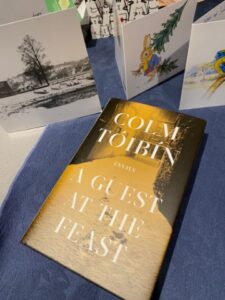Travel in style
Glimpsed in Provence last Summer. Seems a long time ago just now.
Quote of the Day
”We’re all endowed with certain God-given talents. Mine happens to be punching people in the head.”
- Sugar Ray Robinson, world middleweight champion boxer
Musical alternative to the morning’s radio news
Ry Cooder & David Lindley | Jesus on the Mainline | New Orleans Jazz & Heritage Festival
I know, I know: I’ve highlighted this at least a couple of times. The reason: every time it comes up on one of my playlists, I turn up the volume until the neighbours come armed with noise abatement orders. I’m not a religious man, but I wouldn’t mind having it played at my funeral.
Long Read of the Day
Nothing is Real: Craig Brown on the Slippery Art of Biography
I think this essay by Craig Brown is the best thing I’ve ever read on the biographer’s trade. It’s full of insights and sharp observations.
For example:
In the first paragraph of his biography of the Queen, Robert Lacey describes Her Majesty at Balmoral on the Thursday after the death of Princess Diana, reading the newspapers. “Digesting their angry sermons with the long-practised pensiveness which caused her eyes to narrow, her jaw would firm slightly as her thought processes started, shifting her chin forward a fraction—a signal to her staff to think one more hard thought before they opened their mouths.”
This passage raises any number of questions. Was the intrepid Mr Lacey in the Balmoral breakfast room that September morning, perhaps hiding under the table with a periscope to hand? If not, how could he know that the Queen’s reading “caused her eyes to narrow?” And how does anyone, let alone the Queen, set about practising pensiveness? And — since, presumably, Lacey was crouching in her brain, like one of the Numbskull cartoon characters in The Beezer, could he please explain what, if anything, was going on in The Queen’s brain before she firmed her jaw and “her thought processes started”?
Or this:
In 2003, at the age of 45, Mark Lewisohn began researching a history of the Beatles. Ten years later, he published the first volume. The extended version runs to 1698 pages, and only takes the Beatles up to the end of 1962, and the recording of Love Me Do. Lewisohn is now 62, and expects to be well into his seventies before his trilogy is complete. It is, by any measure, an extraordinary achievement, but the detail sometimes threatens to smother the whole. For instance, you may well want to know that George Harrison’s first car was a Ford Anglia. Fair enough. But do you really need to know that it was a second-hand two-door blue Ford Anglia 105E Deluxe, bought by George from Brian Epstein’s friend Terry Doran who worked at a car dealership in Warrington?
It’s all in aid of understanding the perennial problem facing the conscientious biographer: what to put in — and what to take out.
Hope you enjoy it as much as I did.
And if you’re ever bored, Ma’am Darling — Brown’s hilarious biography of Princess Margaret — will see you right.
Books, etc.
One of my sisters gave me this for Christmas. It’s a collection of 11 essays by one of Ireland’s most prolific writers. Initially I thought it would be just one of those collections that writers’ agents bully them into publishing while they are working on the next novel. And because I read most of the periodicals in which his longer pieces appear I expected no surprises.
I was wrong. There’s a marvellous long essay on the Irish judicial system in the 1980s which was published in 2007 in The Dublin Magazine and which I hadn’t seen. And even re-reading some essays that I had read before in periodicals made me see them in a different light. This is especially true of his astonishingly open account of being diagnosed with, and treated for, cancer. Turns out that you can’t judge a book by its cover. My sister has good taste.
My commonplace booklet
Potato-shaped stones are better for skimming, say experts
Scientists have identified particular types of stone that can produce “almighty” leaps out of the water when skimmed across the surface.
While aficionados of the pursuit favour thin, flat stones for long-distance skimming, the researchers’ mathematical model reveals that heavier, potato-shaped stones can achieve more dramatic results, which blast the rock into the air.
“Try some wacky stones and see what happens,” said Dr Ryan Palmer, an applied mathematician at the University of Bristol. “Try and throw a stone that looks like a potato. You can get some fun things happening with heavier stones.”
Palmer and his colleague Frank Smith, a professor of applied mathematics at University College London, created the mathematical model to investigate how the shape and mass of an object affect how it skims on the surface of water.
Do not try this at home.
This Blog is also available as a daily email. If you think that might suit you better, why not subscribe? One email a day, Monday through Friday, delivered to your inbox. It’s free, and you can always unsubscribe if you conclude your inbox is full enough already!


